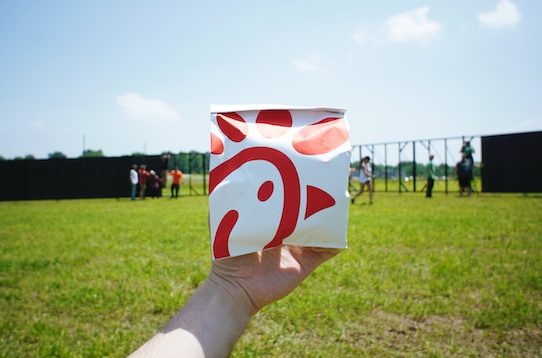Before we dive deep into the SWOT analysis, let’s get the business overview of Chick-Fil-A. Chick-fil-A is an American fast-food restaurant chain specializing in chicken sandwiches and other chicken-based dishes. Founded in 1946 by S. Truett Cathy in Hapeville, Georgia, the company has become one of the largest quick-service restaurant chains in the United States.
Headquartered in Atlanta, Georgia, Chick-fil-A operates over 2,600 restaurants in 47 states and Washington, D.C. The company is known for its signature hand-breaded chicken sandwich, waffle fries, and other menu items such as salads, wraps, nuggets, and milkshakes. In addition, Chick-fil-A offers a range of breakfast items and catering services.
Chick-fil-A has a unique business model, as it is primarily a franchise organization. The company requires a low franchise fee of $10,000 but carefully selects franchisees to ensure they align with its values and goals. Unlike other fast-food chains, Chick-fil-A restaurants are closed on Sundays, following the founder’s commitment to observing a day of rest.
The company is known for its strong focus on customer service, with employees trained to prioritize a friendly and efficient guest experience. This dedication has contributed to high customer satisfaction ratings and strong brand loyalty.
Financial Performance: Chick-fil-A generated net earnings of 1.24 billion U.S. dollars worldwide in 2021. This shows an increase compared to last year’s total of 842.76 million U.S. dollars.
Here is the SWOT analysis for Chick-Fil-A
A SWOT analysis is a strategic planning tool used to evaluate the Strengths, Weaknesses, Opportunities, and Threats of a business, project, or individual. It involves identifying the internal and external factors that can affect a venture’s success or failure and analyzing them to develop a strategic plan. In this article, we do a SWOT Analysis of Chick-Fil-A.
By the way, here is a course that will help you stand out in the world of strategy. The Strategic Thinking program for CxO by Cambridge Judge Business School maps your competitive advantage and teaches advanced techniques to formulate, evaluate, and execute winning strategies. Generate winning strategies and learn how to renew them in times of crisis for a competitive advantage.
SWOT Analysis: Meaning, Importance, and Examples
Strengths
- Brand reputation: Chick-fil-A has built a strong brand reputation for high-quality food and exceptional customer service. This reputation has generated customer loyalty and helped the company stand out in a competitive fast-food market.
- Unique menu offerings: The company’s focus on chicken-based menu items sets it apart from other fast-food chains that primarily offer burgers. The signature hand-breaded chicken sandwich, waffle fries, and other menu items have become iconic and differentiate Chick-fil-A from competitors.
- Customer service: Chick-fil-A is known for its exceptional customer service, with employees trained to provide a friendly and efficient experience. This focus on customer satisfaction has contributed to high ratings and strong brand loyalty.
- Strong franchise model: Chick-fil-A’s unique franchise model prioritizes selecting franchisees who align with the company’s values and goals. This approach, coupled with a low franchise fee, has helped the company maintain a consistent brand image and customer experience across locations.
- Closed on Sundays: The company’s commitment to being closed on Sundays, honoring the founder’s belief in a day of rest, has resonated with many customers, who appreciate its adherence to its values.
- Impressive growth and financial performance: Chick-fil-A has demonstrated strong growth in recent years, with consistent increases in revenue and store count. This growth has positioned the company as the third-largest fast-food chain in the United States by sales.
- Adaptability: Chick-fil-A has shown a willingness to adapt to changing consumer preferences by introducing healthier menu options, investing in technology to enhance the customer experience, and addressing controversies related to its charitable giving.
Weaknesses
- Limited international presence: Chick-fil-A’s presence is primarily concentrated in the United States, with only a few locations in Canada and the United Kingdom. This limited international expansion exposes the company to risks associated with economic downturns or market saturation in the U.S.
- Controversies and public relations issues: Chick-fil-A has faced several controversies, mainly due to the company’s and its founders’ past statements and charitable donations. These issues have led to negative publicity and boycotts, potentially impacting the company’s image and customer base.
- Narrow product focus: While Chick-fil-A’s focus on chicken products sets it apart from competitors, it limits its menu diversity. Competitors that offer a more comprehensive range of products may appeal to a broader customer base, particularly as consumer preferences evolve.
- Closed on Sundays: Although being closed on Sundays is considered a strength by some, it also has drawbacks. The policy results in lost revenue opportunities and may inconvenience customers who prefer to dine out on Sundays.
- Franchisee selection process: While beneficial for maintaining brand consistency, Chick-fil-A’s rigorous franchisee selection process may limit the company’s growth potential by restricting the number of new locations that can be opened.
- Dependence on the U.S. market: With most of its locations in the United States, Chick-fil-A is heavily reliant on the performance of the U.S. economy. Any economic downturn or changes in consumer preferences could significantly impact the company’s revenue and growth prospects.
- Potential for supply chain disruptions: Chick-fil-A’s focus on chicken products makes it vulnerable to disturbances in the poultry supply chain, such as disease outbreaks or price fluctuations. Any supply chain issues could impact the company’s ability to meet customer demand and maintain its high-quality standards.
By the way, to communicate our strategy effectively within the team, we all need a robust collaboration platform. Miro is the leading visual collaboration platform. Build anything together on Miro. It’s free and as easy to use as a whiteboard, but endlessly more powerful. Do use the Miro platform for strong communication within your team.
Opportunities
- International expansion: With a limited presence outside the United States, Chick-fil-A has significant potential for expanding its operations in global markets. Entering new countries can increase brand awareness, diversify revenue streams, and reduce reliance on the U.S. market.
- Menu diversification: Introducing new menu items, such as plant-based or vegetarian options, can help Chick-fil-A cater to a broader range of customer preferences and tap into growing food trends. Expanding the menu can also help the company appeal to health-conscious consumers and those with dietary restrictions.
- Digital innovation: Investing in technology to enhance the customer experience can provide a competitive advantage for Chick-fil-A. Opportunities include expanding mobile ordering, delivery services, and app-based loyalty programs to improve convenience and encourage customer retention.
- Drive-thru optimization: As drive-thru service becomes increasingly important in the fast-food industry, optimizing drive-thru efficiency and layout can help Chick-fil-A attract more customers and boost sales. Implementing advanced technology, such as AI-powered ordering systems and digital menu boards, can enhance the drive-thru experience.
- Strategic partnerships: Collaborating with well-known brands or celebrities can help Chick-fil-A increase its visibility and attract new customers. Co-branding opportunities or limited-time menu offerings can generate buzz and drive customer interest.
- Sustainability initiatives: Demonstrating a commitment to sustainability and corporate social responsibility can improve Chick-fil-A’s brand image and resonate with environmentally conscious consumers. This can include sourcing sustainable ingredients, reducing packaging waste, and implementing energy-efficient practices in restaurants.
- Non-traditional locations: Expanding into non-traditional venues, such as airports, college campuses, and sports stadiums, can provide Chick-fil-A with additional revenue streams and increase brand exposure.
Threats
- Intense competition: The fast-food industry is highly competitive, with numerous well-established chains and emerging players vying for market share. Competitors may offer more diverse menus, lower prices, or innovative services to attract customers, which could affect Chick-fil-A’s sales and profitability.
- Changing consumer preferences: As consumer preferences evolve, there is an increased demand for healthier food options, plant-based alternatives, and sustainable practices. If Chick-fil-A does not adapt to these changing preferences, it could lose customers to competitors that offer more diverse and health-conscious options.
- Supply chain disruptions: Chick-fil-A’s focus on chicken products makes it vulnerable to disturbances in the poultry supply chain, such as disease outbreaks, price fluctuations, or transportation issues. Any supply chain disruptions could impact the company’s ability to meet customer demand and maintain its high-quality standards.
- Regulatory and compliance risks: The fast-food industry is subject to various regulations, including food safety, labor laws, and environmental standards. Changes in regulations or failure to comply with existing rules could result in fines, legal action, or damage to Chick-fil-A’s reputation.
- Economic downturns: Economic downturns or recessions can lead to reduced consumer spending on dining out, which could negatively impact Chick-fil-A’s sales and profitability. As the company relies heavily on the U.S. market, any economic downturn could significantly affect its revenue and growth prospects.
- Public relations issues: Chick-fil-A has faced controversies related to its founders’ beliefs and charitable giving. Further controversies or negative publicity could harm the company’s reputation, lead to boycotts, and impact customer loyalty.
- Labor issues: The fast-food industry faces ongoing challenges related to labor, such as high employee turnover, minimum wage increases, and demands for improved working conditions. These issues could lead to higher labor costs or operational difficulties for Chick-fil-A.









